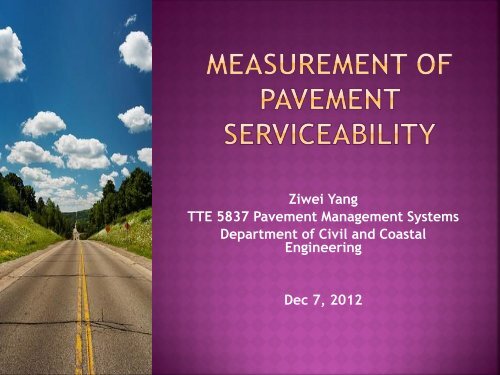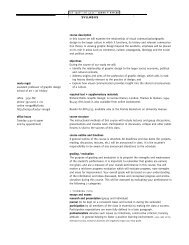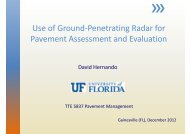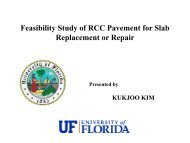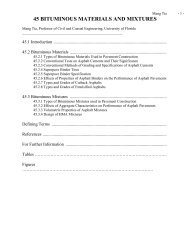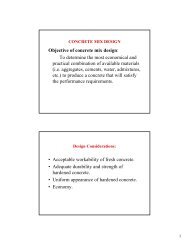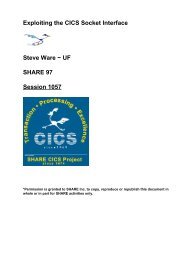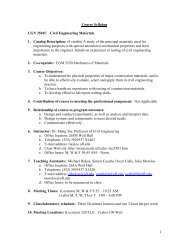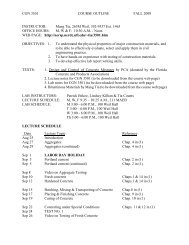Ziwei Yang
Ziwei Yang
Ziwei Yang
You also want an ePaper? Increase the reach of your titles
YUMPU automatically turns print PDFs into web optimized ePapers that Google loves.
<strong>Ziwei</strong> <strong>Yang</strong><br />
TTE 5837 Pavement Management Systems<br />
Department of Civil and Coastal<br />
Engineering<br />
Dec 7, 2012
Introduction<br />
PSI (Present Serviceability Index)<br />
IRI (International Roughness Index)<br />
Correlations Between PSI and IRI<br />
Measurement Techniques
Rideability<br />
Maintenance costs<br />
Vehicle delay costs<br />
Fuel consumption<br />
Roughness!
Serviceability is the ability of a specific<br />
section of pavement to serve high-speed,<br />
high-volume, mixed traffic in its existing<br />
condition.<br />
Road quality<br />
and condition<br />
PSI<br />
IRI
PSI is the foundation of pavement maintenance<br />
decision and road economic analysis. It is used<br />
to judge the condition of the road whether<br />
meet the traffic requirement.<br />
PSI (based on AASHO Road Test) is a<br />
mathematical combination of values obtained<br />
from certain physical measurements so<br />
formulated as to predict the PSR for those<br />
pavements within prescribed limits.
Flexible pavement PSI can be obtained<br />
by the equation (1):<br />
Rigid pavement PSI can be obtained<br />
by the equation (2):
1. Since PSI is based on the AASHO Test data<br />
about 50 years ago, and the vehicles, road<br />
characteristics and traffic speeds have been<br />
improved a lot, the applicability is<br />
questionable.<br />
2. PSI includes not only the rideability but also<br />
the surface defects. For the management of<br />
pavement inventory, it would be better to have<br />
separate measures of ride quality and surface<br />
defects.<br />
3. People use more advanced instruments to<br />
measure roughness, but the PSI equations are<br />
based on the profilometer which is no longer<br />
used today, thus, there must be some errors<br />
using PSI equations.
IRI is used to define a characteristic of the<br />
longitudinal profile of a traveled wheeltrack<br />
and constitutes a standardized roughness<br />
measurement. (m/km; mm/m)<br />
Rougness Experiment was held in Brasilia,<br />
Brazil, in 1982<br />
Sponsored by the World Bank
IRI Roughness Scale
60 inches<br />
RARS80 :<br />
reference average rectified slope @ 80 km/hr<br />
It is the ratio of the accumulated suspension<br />
motion of a Quarter-Car divided by the distance<br />
it traveled with a speed of 80 km/hr during the<br />
test.<br />
1 mile
Disadvantage:<br />
Measurement of IRI has the deviation to asphalt<br />
pavement and against concrete. This is because of<br />
the fact that most concrete pavements have sawed<br />
joints at regular intervals, and given a “rough”<br />
surface.<br />
Advantages:<br />
Better repeatability:<br />
Repeatability refers to the ability of one machine to<br />
get the same result on the same stretch of roadway<br />
in two different passes.<br />
Better reproducibility:<br />
Reproducibility refers to the ability of two machines<br />
to get the same result on the same stretch of<br />
roadway.
Reported by Paterson in 1986<br />
PSI = 5×e (-0.18×IRI)<br />
Al-Omari and Darter in 1992<br />
PSR = 5×e (-0.0026×IRI)<br />
Hall and Munoz in 1999<br />
PSI = 5-0.2397x 4 +1.771x 3 -1.4045x 2 -1.5803x<br />
x = log(1+SV)<br />
SV = 2.2704(IRI) 2<br />
However, since Holman’s equations database is much<br />
smaller, Al-Omari and Darter’s equation is more widely<br />
used.
Profile Dipstick<br />
A handle is mounted on<br />
the frame for walking<br />
A microcomputer is<br />
fixed on the dipstick to<br />
record the data and<br />
computer the slope of<br />
the road<br />
An inclinometer<br />
enclosed in a case which<br />
is supported by two legs<br />
separated by 12 in
MERLIN Instrument: simple and low cost<br />
(Machine for Evaluating Roughness using Low-cost<br />
Instrumentation)<br />
It is a 1.8m long metal<br />
structure, with a wheel<br />
in front, a fixed base at<br />
the rear and an<br />
oscillating central<br />
support. The latter<br />
measures the elevation<br />
of a point with respect<br />
to the grade line<br />
defined by the other<br />
two points.<br />
200 measurements (one record for each revolution of the<br />
instrument’s wheel) have to be made at regular intervals<br />
to determine roughness.
Profilographs:<br />
Widely used for rigid pavement construction inspection,<br />
quality control and acceptance<br />
These devices consist of bogie wheel sets at the front and<br />
rear, a recording wheel at the center and a strip chart<br />
recorder for capturing the movement of the recording<br />
wheel relative to the bogie wheels.<br />
Roughness is recorded by the strip chart<br />
The most common<br />
profilograph is the<br />
truss-type California<br />
profilograph. The<br />
profilograph is pushed<br />
along the pavement,<br />
and 3 to 5 kilometers<br />
of the pavement can<br />
be measured in 1 hour
Profilograph Output<br />
Advantages:<br />
1) The initial cost is low.<br />
2)The operation of profilograph is simple.<br />
3) It has good repeatability.<br />
Disadvantages:<br />
1) The speed of operating a profilograph is low.<br />
2) It is unable to measure roughness at<br />
wavelengths equal to integer multiples of the<br />
wheel base.
Inertial Profilometers<br />
The principal components: the height sensor(s),<br />
accelerometer(s), a distance measuring system,<br />
and computer software and hardware.<br />
Most common height sensors: Laser sensors


